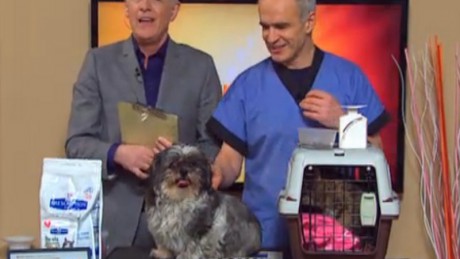
To watch the video of this discussion on puppy farms, click on the play button at the foot of this page.
Puppy farms are a serious animal welfare issue in Ireland
The focus of many campaigners is to call for more legislation to control puppy farms. While it is true that the current legislation does need to be tightened up (e.g. the ratio of one staff member to 25 dogs is inadequate), it’s equally important to try to stop the demand for “designer puppies” by persuading would-be owners to reconsider their choice.
The truth that we spelt out on television last night is that if you buy a designer puppy from a source like a puppy farm, you are directly contributing to the waste by-products of this system, which means stunted, sickly, prematurely aging dogs such as those shown in this video clip.
Choose a rescue dog instead of buying a puppy
- The first message is: choose a rescue dog rather than buying an expensive puppy. Rescue dogs come in all sorts of shapes, sizes and types, and there’s nearly always one that will suit anyone’s needs and wishes.
- The second message is: if you insist on buying a puppy, you need to know how to avoid avoid buying one from a puppy farmer. There’s a very good website called ipaag.ie which basically says “Don’t be fooled by unscrupulous breeders” and there’s a puppy check-list on that website that you can download to make sure you’re not making an elementary mistake when you’re trying to source a puppy.
What else can be done to stop people breeding sickly pups?
Under Irish law, all puppies must be micro-chipped before changing hands. This forms an unbreakable link with the breeder and arguably the breeder can then be held responsible if there are problems with the puppy.
Anyone buying a puppy should double check that the pup has been properly microchipped, and that the breeder’s details are on the database. If this is done correctly, the breeder can be tracked down, and, at least potentially, be held responsible in the future.
In England, the responsibility of breeders to produce healthy animals has been made specific under law. A law that was brought in last year means that anyone running any business involving animals (including dog breeding) must be licensed and is legally responsible for the consequences of what they do. What this essentially means is if a breeder has two adult dogs that have extreme conformation (i.e. the shape and size and the physical structure of the animal), and if they breed from these two dogs and the resulting puppies then have health issues because of their own poor conformation, then the breeder can in theory be held liable.
Arguably, consumer law should cover this type of situation in Ireland but an owner would have to make a case in court. It’s not black and white. My own belief is that Ireland should have a specific law governing the breeding of animals so that people who knowingly breed puppies that predictably suffer from poor health should be held responsible.
What about flat-faced (brachycephalic) breeds of dog?
The other topic that was discussed on Claire Byrne Live was the issue of brachycephalic dogs. Two of the puppies in the studio last night were Pugs that had utterly flat faces, with no hint of a muzzle. One of the pups had already needed surgery to widen its breathing passages because it had suffered from Brachycephalic Obstructive Airway Syndrome (BOAS).
While it is true that many individual Pugs (and many other dogs of breeds like French Bulldogs, Bulldogs and others) have no difficulty breathing, it is also true that these breeds have a far higher incidence of breathing difficulties than other, longer-nosed breeds. It is wrong for humans to deliberately create dogs that have a high likelihood of developing complicated, uncomfortable problems like this. Our aim should be to produce puppies that have a high chance of living healthy lives without needing corrective surgery.
A stronger stance is needed, and one answer is the approach taken in the Netherlands, where it has recently been made illegal to breed dogs with no muzzle.

The new law requires Pugs to have longer muzzles – ultimately 0.5 the length of the skull but in the interim 0.33 (with time given to achieve that). The local Pug Clubs are discussing how to achieve this with geneticists, but it is likely that outcrossing will be used (i.e. cross-breeding Pugs with similar types of dogs with a longer snout). This is definitely in the best interests of dogs in the future, but it is likely to be resisted by those who breed and show Pugs, because it is a change from the current appearance.
As I type this, I know that some owners of these breeds will say that I don’t like their dogs: this is far from the truth. These breeds are adorable individuals, and my only aim is to try to ensure that fewer dogs in the future are born with a body shape that significantly increases the risk of them suffering serious discomfort and illness.
For me, it is all about the health and welfare of dogs.
To watch the video, click on the play button below.




Please note that I am unable to answer veterinary questions in comments. If you have questions or concerns about your pet's health it is always better to contact your vet.